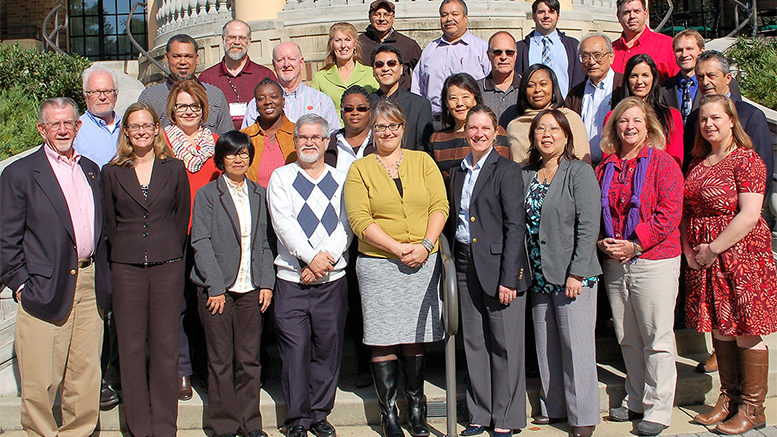All 10 of the colleges in the 2014-2016 MentorLinks cohort made progress on their STEM program improvement goals with advice from a mentor and professional development — and each other.
Comments by the mentees during the cohort’s wrap-up meeting in Washington, D.C. last October made it clear they embraced the community aspect of MentorLinks and learned from their fellow mentees as well as from community college STEM experts who were their designated mentors.
“When we talk about MentorLinks, we always want to stress that it is a community — that your mentor is not just your mentor. You are part of a mentor team,” said Ellen Hause, project director for academic and student affairs at the American Association of Community Colleges (AACC).
In addition to quantifiable program outcomes, faculty members and administrators who participated in MentorLinks all reported that their careers advanced thanks to new professional connections they made through the program AACC offers with support from the National Science Foundation‘s Advanced Technological Education (NSF ATE) program.
Jason Gee, associate dean of Instruction at Arizona’s Mohave Community College, pointed out that his conversation with Abel Castillo, chair of automotive technology at Texas State Technical College, at the 2015 MentorLinks meeting “inspired” him to do more to recruit women. In 2016, he had Mohave devote 20 percent of its federal Perkins funds to marketing efforts aimed at women and other student populations who do not typically enroll in STEM programs.
“I just wanted to thank you for bringing this as an issue,” Gee said to Castillo during one of the wide-ranging discussions the mentees engaged in about the lessons they learned during MentorLinks and the plans for their projects.
Louise Petruzzella, director of clean energy technology and entrepreneurship at Shoreline Community College in Washington, used Twitter to build interest in her program after learning during the 2015 MentorLinks meeting how other participants use social media to recruit students. After several months, she decided that “tweeting” took more time than she had to invest in it.
The flexible structure of MentorLinks and the encouraging tone Hause sets are strengths of the program. To promote innovative approaches, MentorLinks allows mentees to rework their plans and even change objectives, if necessary, when the mentees’ experiments in curriculum or outreach do not work as well as intended.
AACC MentorLink’s request for proposals from colleges seeking assistance to improve STEM technician programs and applications for mentors will be available beginning February 21 at AACC’s MentorLinks webpage. College proposals and mentor applications are due April 28.
Post-MentorLinks plans to work together
Latrice Singletary, computer technology program coordinator at Orangeburg-Calhoun Technical College in South Carolina, commented on the cordial relationships that had developed among the entire group of mentees and mentors during the past two years: “This has been a tremendous time. Thank you so much for this. I think you are all like family. We’re coming in and we’re hugging people now. We’re not just coming in and saying ‘Hi,’ we’re hugging them. Thanks so much for the opportunity.”
Thanks to this bonding, all the mentees plan to continue the projects they started with their $20,000 MentorLinks grants, and about half of the mentees have formal plans to continue working with their mentors on other endeavors.
“What was common with us, with these other [MentorLinks] groups was that we just care about changing students’ lives. And the NSF ATE community steps up to do that no matter what your discipline is,” said Amanda Orzechowski, dean of engineering at South Carolina’s Tri-County Technical College.
Through MentorLinks she received helpful advice beyond the guidance provided by her designated mentor, Gordon F. Snyder, and his colleagues at the National Center for Optics and Photonics Education (OP-TEC), where he is associate director.
She said she also developed an excellent working relationship with Lou Piazza, director of Broadening Advanced Technological Education Connections (BATEC). He helped her sort out the “the golden nugget” among IT trends to incorporate in other STEM programs at Tri-County. Personnel at the Southeast Regional Center for Laser and Fiber Optics Education (LASER-TEC) answered questions and referred her to other helpful faculty for specific information.
“That is the real trick of the NSF [ATE] community … People are willing to pour into the newcomers, to help them, to mentor them, to include them and to help them find their way. They don’t see it as competitive by and large. They see it as being part of the same family,” she said, adding, “There are lots of folks that see that there is room for all of us.”
Brenda Albright, MentorLinks’ evaluator, encouraged the mentees to build on what they learned and the connections they made with the NSF ATE community.
“This is not the end, this is the beginning. There are many, many opportunities for you after MentorLinks,” she said at the close of the meeting.

